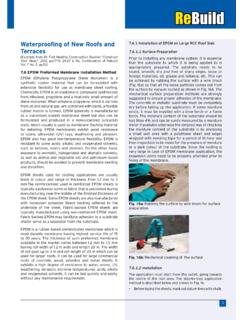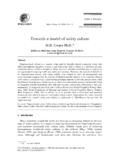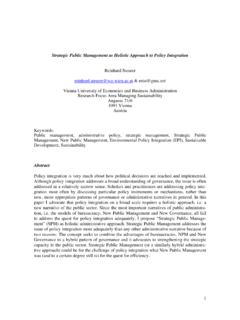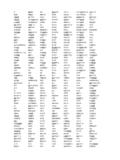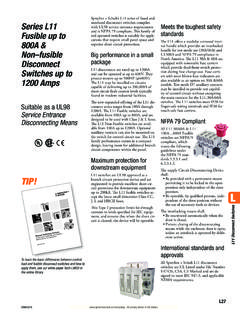Transcription of seismic assessment & retrofitting of rC frame …
1 6seismic assessment & retrofitting of rC frame BuildingsAn abstract of lecture delivered by Dr. Sudhir Kumar Jain, Director, IIT Gandhinagar under Healthy Construction Series organized by Dr. Fixit Institute of Structural Protection & Rehabilitation at Ahmedabad on 20th August Jain is an eminent personality in the field of Earthquake Engineering and also a member of the Team for developing a Rapid Visual Screening(RVS) method for seismic assessment for Indian RC framed retrofit is the method of modification of existing structures to enhance their capability to resist earthquakes.
2 It may be executed on concrete masonry, unreinforced masonry and concrete tilt-up construction. The need for retrofitting arises after the modification of Codes and various other causes as shown in the Fig specifications of IS 1893 : 1984 for seismic resistant design have been inadequate for peninsular India. Even the masonry buildings were never adequately covered before 2002. The current version, IS:1893-2002, made substantial upgradation of seismic zones in order to avoid such surpries in future. Even IS 13920 1993 does not incorporate explicitly the specifications for strong-column weak-beam concepts, which are essential for structural survivability.
3 The codes of practice do not include specifications for the design of beam-column joints, however guidelines are available in 2002 version of IS 1893 has more clearly defined the irregularities (vertical and horizontal) in the configuration of buildings than the earlier versionComparison of 1984 & 2002 versions of is 1893 The deficiencies in the earlier Codes can be made by drawing a comparison with the latest values of base shear coefficient Ah, where base shear Vb = Ah W, Where W is total seismic weight of stucture, for a few cities in different seismic zones are compared for the current and previous versions of the code.
4 It is assumed that I (Importance factor)= and = ; the normalized shape of C (IS 1893 1984) is more or less similar to the shape of spectral acceleration of the 2002 version (it is the same in short period range). Two cases are considered for comparison, namely case I wherein K = (1984 version) and R (Response reduction factor) = (current version), and case II wherein K = (1984 version) and R = (current version). The base shear coefficients are listed in Table 1 for cases I and II, respectively. Table 1. Comparison of base shear coefficients for few citiesCITYIS : 1893 1984 IS 1893 (Part 1).
5 2002 Case - ICase - IICase - ICase - IIK = = = = = [Zone V ]Ah = [Zone V ]Ah = [Zone V ]Ah = [Zone V ]DelhiAh = [Zone IV]Ah = [Zone IV]Ah = [Zone IV]Ah = [Zone IV]Kolkata, MumbaiAh = [Zone III]Ah = [Zone III]Ah = [Zone III]Ah = [Zone III]ChennaiAh = [Zone II ]Ah = [Zone II ]Ah = [Zone III]Ah = [Zone III]Hyderabad, BangaloreAh = [Zone I ]Ah = [Zone I ]Ah = [Zone II ]Ah = [Zone II ]Ah=Vb/W The Tables indicate an across the board increase in the values of the 2002 version. However, it is more pronounced for the cities upgraded to more severe zone such as Chennai, Bangalore and Hyderabad.
6 The increase in those cases varies from 300 to 500 percent depending on the type of structural systems. However, there is no change in the values in the two versions in the case of Mumbai and Kolkata, , if reduction factor R = 5 and K = 1 (for ductile shear wall with Special Moment Resisting frame or Special RC Moment-Resisting frame ). Obviously, as per IS 1893 : 2002, no place in India is deemed to be free from earthquake hazards. TypesDeficient for gravity loadsDeficient for seismic loadsCausesInadequateDesignInadequateCon structionDeterioration inmaterialwith timeMajor alterationin the buildingRe asonsUp gradation ofseismic designrequirementsAdvancementin engineeringknowledgeLack ofunderstandingby the designerDeficiencies indesign Types of deficient buildings their causes and reasons7features of is 1893.
7 2002 (Part 1)This fifth version of the code has given clearer definitions of irregularities in the vertical (elevation) and horizontal (plan) directions in the configuration of buildings. They are briefly as follows:Plan irregularities causing torsion are re-entrant corners, diaphragm discontinuity, out of plane offsets and non-parallel systems. Vertical irregularities are caused by variations in lateral stiffness, mass, vertical geometry, in-plane discontinuity in vertical elements resisting lateral force and discontinuity in capacity like weak story.
8 seismic assessmentThe seismic evaluation can be made by following Visual Screening Procedure: It is used to identify and create an inventory of buildings, to rank buildings that are potentially hazardous. But there is relatively poor correlation between RVS and actual performance building by building. Hence it is useful in a broad sense and for prioritizing the seismic Evaluation. Detailed assessment . Criteria developed under IITK-GSDMA Project on Building assessment can be made by Push over analysis where investigation to be carried out at horizontal load steps equal to 2% of their design capacities and the corresponding inelastic displacements to be rapid visual screening (rvs) Method for indian rC frame Buildings An inter-institutional collaboration between IIT Kanpur (Sudhir K Jain & Manish Kumar),Bengal Engg & Science University, Sibpur (Keya Mitra) and CEPT Ahmedabad (Mehul Shah)
9 Was being made to develop Rapid Visual Screening (RVS) method for seismic assessment for Indian RC Framed buildings. For developing RVS method 6670 buildings from Ahmedabad which is 250 km away from epicenter having shaking intensity of VII (MSK scale) in 2001 earthquake were assessed by CEPT, Ahmedabad. These buildings were assigned damage category (G0 to G5) and subset of 270 buildings were studied. Screening for different vulnerability features were made. Observed Performance Scores (OPS) such as G0=100, G1=85, G2=70, G3=50, G4=25, G5=0 were assigned depending on damage category.
10 The vulnerability parameters were based on statistical regression analyses performed ,presence of basement, number of storeys, current building maintenance(to estimate original construction quality),asymmetric location of staircase,(with respect to plan),reentrant corners, open storeys, substantial overhangs, stub columns, and short columns. From these it was observed that taller buildings, buildings with basements and buildings with good maintenance performed better. The Performance Score can be calculated from the following equation(1).



